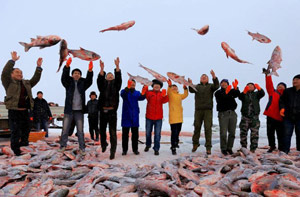News as fast food not a healthy diet
Updated: 2014-07-22 07:47
By David Edwards(China Daily)
|
||||||||
News bots employ this idea and are able to use informational templates for standard situations such as sports games or weather reports because they are data driven. The program chooses a template, strings together sentences and data, with perhaps some pre-programmed catch phrases. At the beginning, Narrative Science applied its algorithms to Little League baseball games. Participating parents would enter game statistics into an iPhone app called GameChanger, which churned out written game summaries.
The news bot was born out of the idea of data-driven journalism, which has been gaining momentum for a number of years. Focused on the power of databases to gather and sort large amounts of data, it seeks to liberate our vast subterranean reserve of digital data for the public as "breaking" or "relevant" news.
At the 2008 Future of Journalism conference, sponsored by The Guardian, journalist and computer programmer Adrian Holovaty articulated this vision by saying that there is a crisis in traditional journalism, because newspapers are losing money, there is a lot of bias in news, journalists are inefficiently wasting much of the powerful raw data at the root of their stories.
Holovaty wants news to be more orientated toward computers, and describes story writing as a process of massaging simple facts-such as location, value of goods, victim/s and date for a robbery story-into a large "blob of information" ready for readers' and viewers' consumption.
The problem is that Google or any other search bot has to search through those blobs of stories to pull out those raw data again. News organizations should therefore develop infrastructure linking data networks with agencies (such as environmental agencies in the case of an earthquake story) to gather information, verify and distribute it because, as Holovaty says, journalism primarily involves gathering information, distilling it and presenting it to "consumers". And data infrastructure and databases should be the tool of choice for the job.
So is Hammond's view that by 2030, about 90 percent of news could be written by computers the result of an innovator's enthusiasm, a real possibility or the output of a news bot gone bonkers?
Bot stories are data driven, which is both their strength and weakness. They are great at trawling for data and scooping up relevant information, and they can do it anytime and much faster than any human being. That makes them good at certain kinds of stories that can be captured by standard templates. But with digital news being very porous, standard news articles circulate rapidly and add little journalistic value to a news brand. As the economies of scale increase, journalistic values decrease.
Contrast this with what may be called a story driven approach. A story unravels over time between cycles of interpretation and research, and journalists link situations and interpretations through complex and nuanced relations such as empathy, morality, values, insight and humor, to name but a few. The result is style.
An individual journalist or group of journalists has a style, and so does a publication. In the digital economy, where news now circulates, style is a competitive advantage that differentiates news providers in the vast landscape of online news. Moreover, it is evident that consumers/readers today want style more than ever. On major online news sites, a high quality opinion and comments section is a significant part of the offering. News bots are great for standardized news production, liberating big data and as a journalistic tool, but taken alone they are the journalistic equivalent of fast food. It is doubtful that consumers desire a diet that constitutes 90 percent fast food.
The author is a researcher on journalism with the University of Nottingham, Ningbo, China.

 Music at her fingers
Music at her fingers
 Across America Over the Week (Jan 16 - Jan 22)
Across America Over the Week (Jan 16 - Jan 22)
 Spend Chinese New Year in style
Spend Chinese New Year in style
 Ili river valley becomes a popular destination for swans
Ili river valley becomes a popular destination for swans
 Philip Ma: from scientist to businessman
Philip Ma: from scientist to businessman
 Birmingham's Spotlight on China dinner
Birmingham's Spotlight on China dinner
 How to distinguish doucai, wucai, Famille-rose and enamel porcelain
How to distinguish doucai, wucai, Famille-rose and enamel porcelain
 Xinjiang lake in bumper fishing season
Xinjiang lake in bumper fishing season
Most Viewed
Editor's Picks

|

|

|

|

|

|
Today's Top News
Houston's SW Chinatown
China to focus on reforms, opening of capital market
Slowdown brings new risks to banks
Trade group calls for BIT
Market status for China is 'political' issue
Birmingham's Spotlight on China dinner
Bank takes renminbi-clearing seriously
Traditional Garb
US Weekly

|

|







